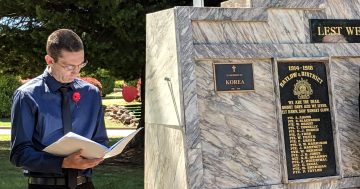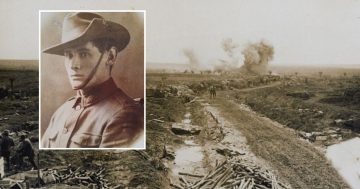
Following a hunt through the gardens and sheds of Batlow, these historic gates have been restored in the town. Photo: Supplied.
It was like a treasure hunt, of sorts, in Batlow that had residents rummaging around in their sheds and backyards. Treasure that had not been sighted since the 1950s.
But before we get to that, let’s head over to Europe, circa 2014, when Kevin and Jo Murrell were on the hunt for Kevin’s great-grandfather.
This is a great-grandfather Kevin knew nothing about. His father had died when he was young and there was never any discussion about that side of the family.

The Batlow Memorial Gates when they were first erected in 1925. Photo: Trove.
Recently, Kevin found himself tapping around on ancestry.com in an effort to explore more of his paternal side, and his grandmother held a vital clue.
“I stumbled upon information on her death certificate that her father was in the ‘permanent army’, and it wasn’t long before an 80-page service file on Sapper William Wrathall – a tunneller with the 2nd Australian Tunnelling Company – was found,” he says.
More research led to French lessons, which led to two tickets to France and a series of tours around the WWI battlefields – Hill 60, Polygon Wood, Bullecourt, Fromelles, Pheasant Wood, Villers-Bretonneux and Ypres.
It was at the Pernois British Cemetery where Wrathall – age 40 at the time of his death – lay, as Kevin and Jo describe, “surrounded by 417 headstones and wheat fields with the most peaceful view of the Somme Valley”.
He was struck not by a bullet, but a train. A tragic death only two months before the Armistice on November 11, 1918. But it wasn’t in vain, it seems, because the discovery of unknown soldiers and untold stories laying beneath the soil in France changed the course of the Murrells lives.
Now, Kevin and Jo are researching and telling those stories one by one.

Jo and Kevin Murrell, in 2019, after the latter was named a Paul Harris Fellow by Batlow Rotary Club for his work researching local wartime soldiers. Photo: Supplied.
Such has been the impact of this research, Batlow Rotary Club named Kevin a Paul Harris Fellow in 2019 in recognition of his research of all the men of Batlow who served and died in WWI.
The Batlow community’s interest in Kevin’s research has also led to the restoration of one of Batlow’s most important pieces of history.
When WWI ended in 1918, beautifully ornate gates with “Batlow Memorial Park”, “1914” and “1918” inscribed on brass plaques were erected to honour the memory of those lives which were lost. They were flanked by heavy cement posts with marble tablets bearing the names of soldiers who didn’t make it home, and topped with machine gun trophies. However, over time, the gates were lost to development of the town.
But Jo’s father, Les Cox, remembered them.
“We decided we’d try to find them,” says Jo.
So the word went out last September and it wasn’t long – just weeks – before four pieces of the gates were found locally. One was being used as a vegetable garden gate.
While not in pristine condition, the gates and all but one of the original plaques were found.
“Dad is a fitter and turner and he was able to restore the broken pieces,” explains Jo.
The gates, resplendently Caulfield green in colour, were finished prior to Christmas 2019, thanks to donations from local groups. They have been remounted at Batlow Memorial Park, which now has a cenotaph bearing the names of local soldiers lost in all wars.
The gates’ original brass plaques are nearing completion, with a new “1914” plaque in the making.
“Our vision when we put the memorial gates up – similar to what the Australian War Memorial does – is to try and have a place where people can put a poppy on the gate in memory of somebody,” says Jo.
An official opening is still in the pipeline, but already the restoration has given the small Batlow community, which was impacted by the Dunns Road bushfire in early January, an enormous boost.
“It’s been incredible, the response,” says Jo. “It’s been great to have a piece of history put back into our town especially after the fires.”
To learn more about Kevin and Jo’s Beyond the Front Line research, click here.









